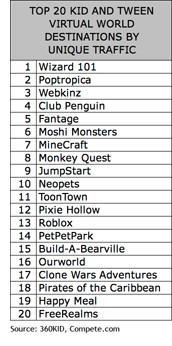Wednesday, July 6th, 2011
[The following is an article I wrote for the July 2011 issue of Children’s Technology Review. If you’re interested in learning more about my recent virtual world research, you can purchase an expanded report by emailing me at scott (at) 360KID (dot) com with “Virtual World Research Report” in the Subject line. My next quarterly report will be completed on July 20, 2011]
It’s been amazing to watch the virtual world (VW) space grow by leaps and bounds over such a short time. Using unique user traffic as a yardstick, the virtual world and massively multiplayer online (MMO) space increased more than 50% last year. Compare that with 15% for the prior year (in the US). The first thing to note is that traffic patterns seem to follow a seasonal rise and fall. Traffic increases from spring to early summer only to drop significantly when school starts in September. Then, as the holiday season approaches, it peaks before dropping off again in the new year.
WHAT’S HOT? The most popular destinations for both kids and adults are “casual gaming” destinations. For kids and tweens, that means Wizard 101, Poptropica, Club Penguin and Moshi Monsters (which was just valued at $200 million). While social and chat-based destinations like IMVU and Hi5 fall in second place for the young adult and older crowd, destinations that have a toy tie-in or real world connection, like Webkinz and Build-A-Bearville hold second place for kids and tweens. However, this VW/MMO type has been on a slow two-year decline, largely as a result of Webkinz loosing significant marketshare over that period, to newcomers like Wizard 101 and Poptropica. While Club Penguin has dropped in placement on the best top 10 list for kids, it has done a surprisingly good job of maintaining marketshare, loosing only a small percentage compared to Webkinz.
Two destinations have really taken off. Minecraft, a “better than LEGO Universe” online building (or “craftingâ€) world that appeals to both boys and girls is growing at an amazing rate globally. The funny thing about Minecraft is that it is still in public Beta! It’s not even a fully released product yet. (Note to execs, learn from this product’s creative expression thinking AND business model!) If you are not yet familiar with this low res, yesteryear looking world, tonight’s homework is to get familiar with it, NOW. Educators should note that teachers are beginning to create lesson plans around Minecraft’s in-world building activities. The second destination of note is Nickelodeon’s latest virtual world offering, Monkey Quest. This new 3D world is also growing quickly since its launch earlier this year and you can’t miss the advertising on Nickelodeon cable channels throughout the day. It’s a world that spent more than a couple of years in development and the polish shows now that it’s ready for prime time.
As we head into the summer months, the kids VW/MMO industry typically assumes that as the dog days of summer drag on, kids will become bored and start to gravitate to virtual world activities from the indoor comfort of an air conditioned room. If you watch any amount of children’s commercial television during the summer you can’t help notice the number of virtual world advertisements. However, while it is unclear if subscription rates actually rise during the summer months, unique traffic to kids VW/MMOs actually falls through July and August, especially in the casual gaming sector and in the toy and web connect space, an interesting trend that goes against popular belief.
What about education-based destinations? You might imagine these kind of sites have some appeal with younger audiences and kids, right? While the casual gaming space has captured almost 34% of all VW/MMO traffic, educational destinations hold less than 6% for all ages, and only 4.4% of all traffic for the top 20 kid and tween educational destinations. Out of this list, a majority share of traffic goes to Knowledge Adventure’s JumpStart and their new and fast growing world Math Blaster. Almost all other destinations show small numbers in comparison.
As I look back on the virtual world and MMO data I have collected over the past five years one thing is certain; expect to see many more virtual worlds launching in the months and years ahead. I remember a few years ago hearing one day there will be over 300 virtual worlds globally. I remember thinking “that’s impossible, we will never have that many.” Well, that day has recently come and gone. I continue to add another ten destinations to my list every month. Adding more new worlds to the existing list of players will create challenges for everyone in this field, pushing all players to continually improve, build out, and try to hold onto market share. Ultimately it will be the children and their parents that will benefit. Each new world that launches raises the bar for quality, engagement, innovation and ultimately, access. That’s the good for kids, but it presents an ongoing challenge for publishers who choose to play in the virtual space.


